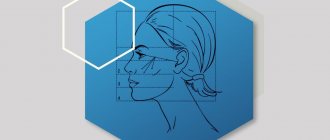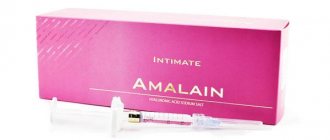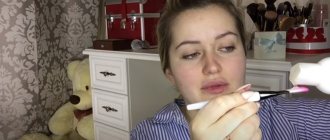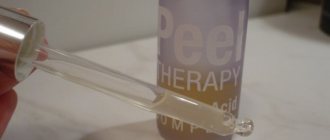A small number of women know how effective lactobione facial peeling is. This procedure is new and has not yet become widely known. Lactobionic exfoliation is considered a latest generation procedure among cosmetologists and their clients. This type of exfoliation is gentle, but has a noticeable effect on the skin: it prevents aging, restores elasticity, and eliminates many defects of the epidermis. Although characterized by positive reviews, lactobionic exfoliation has contraindications and can cause adverse reactions. To prevent the negative consequences of exfoliation, you need to contact an experienced salon specialist.
Description of peeling
Lactobionic facial peeling is one of the most popular new generation chemical peels today.
The product has a gentle, minimally irritating effect and does not cause burning or itching during application. It effectively affects skin of any age, fights acne and post-acne.
Buyanov Sergey Yurievich (Expert Doctor):
Products with lactobionic acid have an important advantage - they do not stimulate, that is, they do not encourage already “tired” cells to produce the connective tissue framework of the skin, but they slow down the breakdown of existing collagen fibers.
The gentle effect of peeling is based on the large size of the molecules of the active substance - they penetrate the skin gradually without damaging the epidermis.
Lactobionic acid is obtained from the oxidation of the disaccharide lactose and contains gluconic acid and galactose. This compound has been used in the cosmetology industry relatively recently, but has already won the hearts of many masters, as well as their patients.
Indications for use
- Skin hyperpigmentation;
- Acne;
- Post-acne;
- Comedones;
- Photoaging;
- Age-related skin changes;
- Premature aging, wrinkles, including facial wrinkles;
- Scarring;
- Striae;
- Ingrown hairs;
- Skin restoration after minor surgeries and other cosmetic procedures.
Efficiency
Lactobionic peeling has a high level of biological compatibility with human skin, due to which it rarely causes allergic reactions.
It has an antioxidant effect, fights photoaging and age-related skin aging, stimulates the process of collagen and elastin synthesis, and skin regeneration thanks to galactose.
Exfoliation of the upper layers of epidermal cells is carried out delicately, so after the procedure only subtle hyperemia remains on the skin, which quickly passes.
Often the product is used after more traumatic procedures (laser resurfacing, microdermabrasion) for a kind of “smoothing” of the effect.
Indications for use
Peels based on lactobione lactobione are considered chemical variants of promising exfoliants with a mild effect. Procedures using the products can be performed by owners of different types of skin (including dry, sensitive, problematic) regardless of age or season.
Cosmetologists call the following indications for performing lactobione peeling:
- deterioration in the appearance of the skin (loss of elasticity, firmness, sagging);
- persistent hyperpigmentation;
- post-traumatic scars, acne scars, ingrown hairs;
- strong predisposition to inflammation;
- clogged, enlarged pores, tendency to increased sebum secretion;
- signs of aging (wrinkles of varying depths, broken oval boundaries, displaced facial features).
Exfoliation intervention is performed as a preventive or therapeutic measure.
Popular drugs
Alpika
The brand provides two lines: Green and White. The products are produced in bottles made of dark opaque glass with a dispenser in the form of a pipette, a pump and a simply unscrew cap.
The 5% concentration is intended for superficial peeling. 15% and 37% for the median.
1. LACTOBIONIC GREEN 5% - ph 2.6; 15%- ph 2.0; 37% - ph 1.3.
The product is used for rosacea, photoaging, hyperpigmentation, scars, stretch marks, acne and post-acne, and improves the condition of aging skin.
Volume - 30 and 80 ml. Cost from 1500 to 3000-6000 rubles.
The product is colorless, has a liquid consistency and practically no odor.
Compound:
- lactobionic acid;
- mandelic acid;
- Apple acid;
- wine acid.
Result: smooth skin, evening out complexion tone, lightening, post-acne and stretch marks disappear. Skin with signs of aging is renewed, fine wrinkles disappear.
2. LACTOBIONIC WHITE 5% - ph 3; 15% - ph 2.7; 37% - ph 1.8.
The products in this line have a pH close to natural, so their effect is even more gentle. The product is used to combat oily and problematic skin, hyperpigmentation, photoaging, and reduces enlarged pores.
The cost ranges from 1,700 rubles (for 5% of the composition with a volume of 30 ml) to 4,000-7,000 rubles for more concentrated products of larger volume.
Compound:
- lactobionic acid;
- lactic acid;
- salicylic acid;
- malic, tartaric and citric acids.
Result of application: achieving balance in the functioning of the sebaceous glands, reducing pore size, evening out complexion and lightening age spots.
The next popular product is produced by the Polish brand Bielenda. The company supplies the market with both professional and consumer products. Let's look at a few examples:
Bielenda professional
The series is represented by two exfoliants with surface action. The difference lies in the concentration of mandelic acid. Let's look at the characteristics of both.
1. Professional peeling “40% Mandelic acid + AHA + Lactobionic acid.”
Used to cleanse the surface layers of the epidermis.
Effective removal of dead skin cells makes the skin fresher, firmer and smoother. The complex of acids delicately whitens age spots, evens out the microrelief, normalizes the functioning of the sebaceous glands, the synthesis and secretion of sebum, and fights acne.
Lactobionic acid triggers the processes of cellular renewal and tissue regeneration, awakens the skin's natural defense mechanisms. Peeling stimulates the synthesis of collagen and elastin fibers. Mandelic acid has an antibacterial effect.
Available in a 150 ml bottle with a convenient dispenser, the price ranges from 2500-2700 rubles.
Result of application: due to the regulation of sebum production and the functioning of the sebaceous glands, the skin becomes elastic, less oily and susceptible to inflammatory processes, fine wrinkles disappear, the tone of the face is evened out, and age spots are lightened.
This product is available not only to certified professionals, but also to home users. You can buy it in almost any online store. However, a fairly large percentage of acids requires extreme caution in use.
2. Universal cleansing gel for exfoliation 10% Mandelic acid + AHA + Lactobionic acid.
Indicated for home use.
Peeling gently exfoliates horny scales, makes the skin vibrant, elastic, and evens out color. Has an antioxidant effect.
The product has a liquid gel-like consistency without a strong odor. Sold in an ergonomic 200 ml bottle, the lid closes tightly and opens easily. The cost is within 600-700 rubles.
Compound:
- mandelic, glycolic, lactobionic, lactic acids;
- urea.
Result: systematic use of the product gives the skin freshness and an even tone.
Bionic Face Serum NeoStrata
The facial serum is designed to care for dry and sensitive skin, carefully removing dead skin cells from the epidermis. The product moisturizes the skin and promotes tissue renewal.
The serum is sold in bottles with a convenient dispenser. Price - 4,000 rubles (30 ml) and 10,000 rubles (100 ml).
Compound:
- gluconolactone;
- lactobionic acid.
Result: a light exfoliant for dry skin will make its texture smoother, remove minor age spots and inflammations, and even out the complexion.
Arkana MD Therapy Lactobionic Exfoliator 22%
The Polish brand offers cosmetics for salon and home care for face and body skin.
Exfoliator with 22% lactobionic acid can be used in the salon or at home.
A surface-acting product, suitable for any age, it can be used on sensitive and dry skin.
Peeling fully copes with its task of exfoliating dead cells, evens out the complexion, restores the epidermis's defense mechanisms, stimulates regeneration and moisturizes.
Available in a 50 ml bottle, it has a translucent liquid gel-like consistency and a neutral aroma. Hypoallergenicity is a nice bonus.
Cost - 4,000-4,500 rubles.
Compound:
- hydrogenated castor oil;
- lactobionic acid.
Result: the product soothes dry and irritated skin, it becomes hydrated, firm and elastic.
NeosBioLab Lactobionic Peeling
Professional neosbiolab product based on 20% lactobionic acid is intended for superficial chemical peeling.
It has a gentle exfoliating effect and intensively moisturizes for 24 hours. Suitable for all skin types.
The product is sold in bottles of 50 ml and 100 ml, has a fairly liquid gel-like texture and an unobtrusive smell. You can buy it for 2,000-4,000 rubles.
Compound:
- lactobionic and lactic acids;
- macrocystis piriformis extract;
- hydrolyzed vegetable protein;
- sugar beet root extract.
Result: quick lifting effect, intense hydration, even out tone and texture of the face.
INCI: Lactobionic Acid
CAS : 96-82-2 EC : 202-538-3
Solubility : Freely soluble in water. Slightly soluble in: acetic acid, anhydrous ethanol and methanol.
Type : solution Color : transparent
pH: 1.0–3.0
Application : Moisturizing, anti-oxidation, anti-aging, wound healing, etc.
Dosage:
- Daily care: 0.5–2.0%
- Intensive care: 2.0–25.0%
Storage:
Store in a cool place. Keep container tightly closed in a dry and well-ventilated place.
Chemical formula: C12H22O12
Composition: ≤100%
How does the procedure work?
When it comes to salon care, it is important to choose a competent, qualified specialist, and after the service is provided, strictly follow all his recommendations.
In the cabin
- At the first stage, the cosmetologist removes facial makeup, then cleanses and tones the skin with special compounds.
- When the skin dries, apply the peeling solution using a brush according to the following pattern: forehead, temples, face contour, chin, nose and cheeks. The movements of the hand are single and quite fast, with the same pressure. Exposure 15-20 minutes.
- The next step is to neutralize the effect of the drug with a special tonic and wash with plenty of water.
- At the end, use a nourishing mask, tone the skin and apply moisturizer and sunscreen.
The duration of the course depends on the skin type, the problem being solved and the products used. Masters use peelings of 15-20% and higher.
A standard course takes 5-6 procedures. In this case, for the first 2-3 sessions, the cosmetologist works with a product with a lower acid concentration, later the percentage increases. On average, the interval is 7-10 days.
After the procedure, you should avoid contact of the treated skin with water for 12 hours.
For home use
Home remedies contain weaker acid solutions.
Application scheme:
- Makeup removal, washing with gel or foam;
- Apply peeling with fingertips (follow instructions on package);
- At the end, the composition is washed off with plenty of water, the skin is toned and a moisturizer is applied.
The procedure is carried out as basic care, 1-2 times a week. You can carry out a course of treatment lasting 3-4 weeks, and then take a break.
Buyanov Sergey Yurievich (Expert Doctor):
It should be borne in mind that peeling with lactobionic acid is most effective on areas of dry skin; increased function of the sebaceous glands prevents the “work” of lactose-based chemicals.
Healing period
To restore, prevent severe peeling, and also to consolidate the effect obtained, you should:
- Do not wet your face for the first 24 hours and avoid exposure to ultraviolet rays;
- on the second day, cleanse the skin only with warm herbal decoction or filtered water;
- from the third day, begin treatment with agents that activate cell regeneration and have a moisturizing effect;
- use sunscreen every time before going outside;
- When a film appears on the skin, do not remove it with your hands - this can cause scars.
After lactobione peeling, you need to avoid visiting a solarium or swimming pool for a month, and also avoid increased physical activity that leads to heavy sweating.
If necessary, a specialist may prescribe a course of antioxidants or a vitamin complex for the rehabilitation period.
Precautionary measures
Before carrying out the procedure at home, make sure your individual tolerance to the drug. After peeling, be sure to use cream with SPF and moisturizers. Active sun and direct sunlight should be avoided.
Contraindications
Almost all such drugs have general contraindications:
- childhood and adolescence.
- Atopic dermatitis.
- Hives.
- Individual intolerance to individual components of the drug.
- Inflammation on the skin of the face (pustules with the release of purulent-necrotic contents).
- Herpes on the face.
- Exacerbation of chronic dermatological diseases.
- Fever of any origin.
- Oncological processes.
- Epilepsy and other mental illnesses accompanied by seizures.
- Damage to the integrity of the skin (wounds, scratches, abrasions).
- Recent hair removal, visiting a solarium, sauna or steam bath.
Preparatory stage
When performing lactobione peeling from a cosmetologist, you must first meet with your doctor to prepare for the procedure. This will help eliminate contraindications, detail the upcoming process: determine the number of interventions, select a drug.
At home, for preparation, light fruit exfoliations begin 7–14 days in advance (including cosmetics with a low content of AHA acids). During this period, it is mandatory to use products that protect against ultraviolet radiation.
Note! It is recommended to choose the right time to perform lactobione peeling: the intervention is not limited to the season, but the autumn-winter period is always preferable. It is necessary to maintain health and integrity of the integument.
Side effects
The occurrence of unwanted side effects is associated with two factors. The first is the unprofessionalism of the cosmetologist and, as a result, a violation of the technology of the procedure and the rules of asepsis. The second factor is the patient himself.
Unfortunately, it is not uncommon for people to unconsciously, and sometimes even purposefully, hide any important details about their health. As a result, it is not possible for the doctor to assess the risk and feasibility of a particular procedure.
Main complications and side effects of peeling:
- allergic reactions of varying degrees (from urticaria to anaphylactic shock);
- hyperemia, swelling, itching of the face;
- skin infection;
- hyperkeratosis;
- hyperpigmentation.
Properties of lactobionic acid
Action of lactobionic acid:
- Activation of regeneration processes, restorative and healing effects. Using this product to eliminate dead cells in acne will not lead to scarring or inflammation.
- Improved collagen production, which promotes skin rejuvenation.
- Gradual penetration into the layers of the dermis increases effectiveness and reduces the risk of complications.
- Moisturizing – an invisible protective film forms on a cleansed face, which helps retain the necessary moisture.
- Cleansing clogged pores and reducing the negative effects of free radicals.
Lactobionic cleansing is allowed to be used at any time of the year - this will not lead to negative reactions.
Opinion of cosmetologists
Cosmetologists and pharmacologists shared their opinions on home and salon peelings with lactobionic acid:
Advantages and disadvantages
A clear advantage of the procedure is comfort and ease of intervention. Anyone can buy a ready-made product and apply the substance according to the instructions. The procedure is characterized by the absence of a visible rehabilitation period. Recovery is quick, painless, and without affecting your appearance. This is not possible with the same superficial Jessner peel, a yellow version of exfoliation.
The disadvantage of this method is that only professional products (peels with a high content of active ingredients) are highly effective. Simplified forms of drugs have a beneficial effect, but do not give dramatic results.










